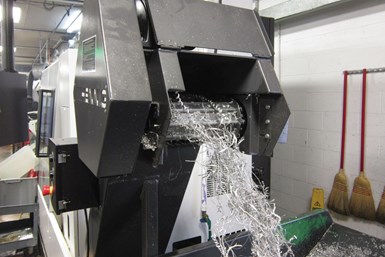
Chip clogging is a common cause of chip conveyor issues. However, this Hennig unit installed on a turning center at Cookeville, Tennessee’s Custom Tool, features conveyor teeth that enable it to better handle long, stringy chips created during some turning operations. (Photo Credit: PM)
There are various reasons why a machine tool’s chip conveyor isn’t functioning as it should, a prime one being a clog of excess chips or other material. In some cases, a shop can fix the problem itself. Other situations might require assistance from the chip conveyor manufacturer. What follows is advice from Hennig, manufacturer of chip management, machine protection and facility safety equipment, to troubleshoot conventional chip conveyors if a problem were to arise.
To start, safety comes first if you choose to have your maintenance personnel look into the problem. Be sure electrical power to the chip conveyor is off. If your personnel is not familiar with the system or hasn’t performed maintenance on such devices before, it’s recommended you contact the manufacturer so as not to risk injury or even death.
Featured Content
When getting started on your own, it’s first important to identify what issue your chip conveyor is experiencing, which could be related to the power supply, motor, drive, rails, frame or belt.
First, run the chip conveyor in reverse to determine if the unit is getting electrical power and the motor is functioning. If the motor is not functioning even though electrical power is being delivered to it, unbolt it so the manufacturer can check if it’s running properly. After unbolting the motor, you’ll also want to remove the motor from the driveshaft to check driveshaft condition. In a chip conveyor such as a Hennig unit, you’ll be able to locate two sprockets, one driveshaft and three keys to do that.
And, while your first thought might be to repair a bad motor yourself, it typically makes more sense to replace the motor and gearbox. Motor replacement cost typically starts at $1,200, although it’s recommended to contact the chip conveyor for an accurate quote.
On the other hand, a functioning motor is generally good news. If your motor is still running, you could have a ball of chips, cutting tool or finished part jamming the unit. Clear any obstruction and test the chip conveyor to determine if that was the problem.
If your motor is still running, you could have a ball of chips, tool or finished part jamming the way.
If that doesn’t remedy the situation, run through this checklist to identify the potential problem(s):
- Check for worn drive elements such as sprockets, sprocket keys, motor key and driveshaft. Replacement parts can be ordered from the chip conveyor manufacturer.
- Try moving the belt by hand. Cranking the driveshaft with a wrench can help you identify if it’s an electrical or motor issue. If your chip conveyor is still moving, it probably means the motor must be replaced.
- If the belt can’t be moved by hand, examine the belt assembly. One of the most common chip conveyor issues is a shaft that has pulled out or has become bent. This typically happens because the crimp on the shaft of the belt is worn. The belt will become jammed when the side link where the shaft has been pulled back has fallen and causes a jam where the belt turns a corner.
- If you’re able to run the chip conveyor in reverse, move the damaged shaft up to the discharge end so your maintenance person has access to the shaft to perform the repair. Once you’re able to access the damaged shaft, remove it by grinding off the crimps to separate the belt. You’ll want to purchase a conveyor hinge kit to replace the damaged hinge.
- If you’re unable to run the conveyor in reverse, locate any shaft you’re able to access and grind off the crimps to divide or split the belt . Once the belt has been split, you can attempt to remove the belt from the chip conveyor.
- If you’re unable to remove the belt, grind the belt shaft crimps. Use the coolant slots as an access point to gain some movement if your conveyor has those slots. You’ll need to purchase a hinge kit to replace the damaged hinge.
- If you have only a few damaged shafts or hinges, purchase a hinge kit to get your chip conveyor in working order. If there are multiple problems with your belt (traditionally when there are issues with more than 20% of the belt), it might be time to order a replacement belt as well.
- Examine the chip conveyor’s frame and rails. Damaged rails can prevent the belt from traveling properly. Take a close look at the chip conveyor for signs of wear such as holes, grooves, dips and so on. Any of these signs of damage can lead to larger issues, including motor and belt failure. If you’ve identified any significant damage to the frame or rails, it’s likely time to replace the chip conveyor.
RELATED CONTENT
-
High-Volume Machine Shop Automates Secondary Ops
An Ohio contract shop added a compact, self-loading CNC lathe to perform unattended secondary ops on a part for a key customer rather than running it on a manually loaded chucker.
-
The Promise of a New Access-to-Capital Model
A free online loan prequalification tool currently offered in Colorado with the potential for introduction to other U.S. markets can enable manufacturers to more easily finance new technologies including automation equipment.
-
Inverting Turning and Five-Axis Milling at Famar
Automation is only the tip of the iceberg for Famar, which also provides multitasking options for its vertical lathes and horizontal five-axis machine tools.






